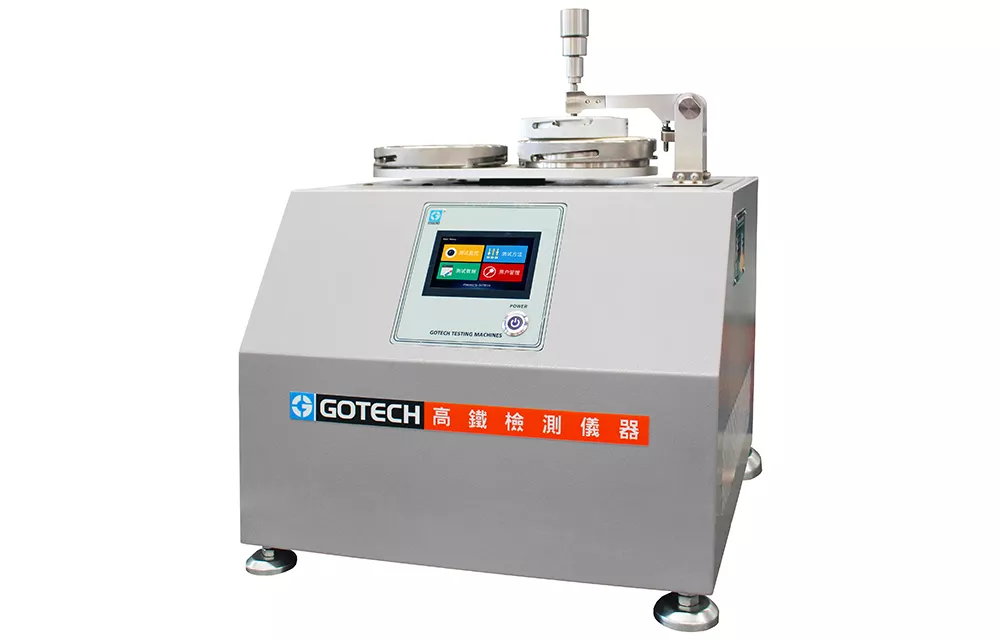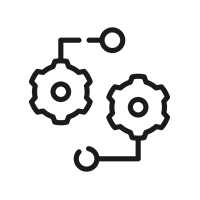
- The GT-7028-PA uses the circular locus method to determine the fabric propensity to surface fuzzing and pilling.
- This tester uses a nylon brush and fabric abrasive (or fabric abrasive only) to rub against the specimen, causing fuzzing and pilling on the fabric's surface. The fuzzing and pilling performance are then visually assessed under specific lighting conditions.
-
Standards
- GB/T4802.1-2008
Principle
This tester uses a nylon brush and fabric abrasive (or fabric abrasive only) to rub against the specimen, causing fuzzing and pilling on the fabric's surface. The fuzzing and pilling performance are then visually assessed under specific lighting conditions.
Circular path testing:
Applies the circular locus method to simulate the friction during real-world use, providing authentic and reliable test results.
Flexibility:
The fuzzing and pilling stations can rotate 360°, allowing operators to quickly switch between different test modes as needed, enhancing both operational efficiency and testing flexibility.
Visual assessment:
Allows for the visual assessment of fabric specimens for fuzzing and pilling under specific lighting conditions, ensuring direct result determination.
Dual test station:
Equipped with fuzzing and pilling stations, allowing the operator to select the station as needed.
Test load:
Test weights can be stacked, providing various weight combinations to meet different testing requirements.
Nylon brush platform (provided by customer):
The nylon filaments should have a 0.3mm diameter and uniform stiffness. Each 4.5mm filament hole, spaced 7mm apart, contains 150 filaments. The flat brush surface features an adjusting plate to control filament height, enabling controlled fuzzing.
Fabric abrasive (provided by customer):
2201 full wool gabardine, 2/2 right twill weave, yarn density of 19.6tes × 2, Z625-S700 twist, density of 445 threads/10cm×244 threads/10cm, and 305g/m^3 areal density.
Quality assurance:
The fuzzing and pilling tests are used for quality control in fabric production to ensure the fabric products meets specific quality requirements.
Material research:
Assists manufacturers in evaluating fabric performance for fuzzing and pilling to improve material quality.
Standard conformance:
Ensures that products meet industry standards and satisfy quality expectations in the market.
-

360° station rotation
The fuzzing and pilling stations can rotate 360°, enabling users to easily switch between working modes as needed.

Multifunctional
Designed to support both fuzzing and pilling tests, reducing time and operational costs.

Touchscreen interface
The intuitive and user-friendly touchscreen interface allows operators to easily set parameters and control the tester.
-
 左右滑動看表格
左右滑動看表格
*Product design and specifications are subject to change without notice.Relative movement path of clamping head and abrasive platform Circular path with a 40mm diameter Relative movement speed of clamping head and abrasive platform 60rpm Inner diameter of specimen clamping ring 90±0.5mm Test load 490cN, 590cN, 780cN Items to be provided by customer Nylon brush platform and fabric abrasive Dimensions (WxDxH) 50×45×65cm Power 1∮ AC 220V 50/60Hz (or specify)
-
Details
Standards
- GB/T4802.1-2008
Principle
This tester uses a nylon brush and fabric abrasive (or fabric abrasive only) to rub against the specimen, causing fuzzing and pilling on the fabric's surface. The fuzzing and pilling performance are then visually assessed under specific lighting conditions.
Circular path testing:
Applies the circular locus method to simulate the friction during real-world use, providing authentic and reliable test results.
Flexibility:
The fuzzing and pilling stations can rotate 360°, allowing operators to quickly switch between different test modes as needed, enhancing both operational efficiency and testing flexibility.
Visual assessment:
Allows for the visual assessment of fabric specimens for fuzzing and pilling under specific lighting conditions, ensuring direct result determination.
Dual test station:
Equipped with fuzzing and pilling stations, allowing the operator to select the station as needed.
Test load:
Test weights can be stacked, providing various weight combinations to meet different testing requirements.
Nylon brush platform (provided by customer):
The nylon filaments should have a 0.3mm diameter and uniform stiffness. Each 4.5mm filament hole, spaced 7mm apart, contains 150 filaments. The flat brush surface features an adjusting plate to control filament height, enabling controlled fuzzing.
Fabric abrasive (provided by customer):
2201 full wool gabardine, 2/2 right twill weave, yarn density of 19.6tes × 2, Z625-S700 twist, density of 445 threads/10cm×244 threads/10cm, and 305g/m^3 areal density.
Quality assurance:
The fuzzing and pilling tests are used for quality control in fabric production to ensure the fabric products meets specific quality requirements.
Material research:
Assists manufacturers in evaluating fabric performance for fuzzing and pilling to improve material quality.
Standard conformance:
Ensures that products meet industry standards and satisfy quality expectations in the market.
-
Features

360° station rotation
The fuzzing and pilling stations can rotate 360°, enabling users to easily switch between working modes as needed.

Multifunctional
Designed to support both fuzzing and pilling tests, reducing time and operational costs.

Touchscreen interface
The intuitive and user-friendly touchscreen interface allows operators to easily set parameters and control the tester.
-
Specifications
 左右滑動看表格
左右滑動看表格
*Product design and specifications are subject to change without notice.Relative movement path of clamping head and abrasive platform Circular path with a 40mm diameter Relative movement speed of clamping head and abrasive platform 60rpm Inner diameter of specimen clamping ring 90±0.5mm Test load 490cN, 590cN, 780cN Items to be provided by customer Nylon brush platform and fabric abrasive Dimensions (WxDxH) 50×45×65cm Power 1∮ AC 220V 50/60Hz (or specify)

